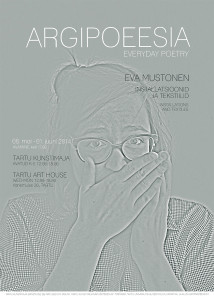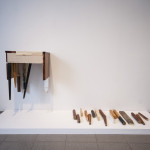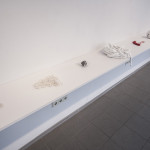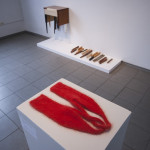 Eva Mustonen “Argipoeesia “
Eva Mustonen “Argipoeesia “
08.05. – 01.06. 2014
Argipoeesia. Kas tegemist on oodiga kasututele esemetele või kasutute esemete valmistamisega? Ood on see mõlemal juhul, sest midagi on esitatud justkui tähelepanu nõudvana. Ood juba seetõttu, et igasugune argise ja juhusliku taasloomine on romantiline ettevõtmine. Nagu päeviku pidamine: mitte midagi polegi juhtunud, aga kirjutatuna muutub just ebaoluline ilmekaks. Ja siis teha seda veel tindi ja sulepeaga. Kohvi juues. Šokolaadi süües. Pihtides oma järjekordset spliini tundetule paberile. Hea seegi.
Välja pandud esemed on argised ja ka argisel moel tehtud. Kootud, tikitud, haamri ja naelaga kokku löödud jne. Neil pole üksteisega suuremat seost peale selle, et neid saaks justkui tarbida. Või neil on selline taust ning see esemelikkus on senimaani äratuntav. (Imelik, et mahalõigatud patsist saab ka “tarbitud ese”). Neid on valmistatud, ning see eeldab otstarbekust. Kootakse käpikud-sallid, tikkides saab parandada-kaunistada, näpunööri tehes saab endale soetada meelepärase nöörijupi (olen kohanud isegi näpunööritehnikas kaevuköisi). Kuigi nende äratuntavus esemetena on jäänud, on kadunud nende otstarve. Kindad, mis takistavad käsi kasvõi taskusse pistmast. Tänavalt leitud märg tekk. Otsast otsani täistikitud kangas. Redel, mille otsa ei saa ronida. Kapp, mille sahtleid ei saa lahti teha.
Muidugi, esemed ei peagi olema ranges mõttes esemed (eriti, kui need on galeriis välja pandud, kuigi antud juhul poleks meil enam millestki rääkida, kui nimetaksime neid kunstiteosteks). Nende esemelisus on metafoor argipäevale, kust nad pärit on või kuhu nad justkui kuuluvad. Mingid settinud tunded või juhuslik mõte on leidnud väljundi nende tuttavlikus vormis. Kuidagi teisiti olekski raske päevast päeva venivaid meeleolusid või ähmaseid äratundmishetki esitada.
Samas on keeruline väljapanekust kokku joonistada “nii ma siis elangi”, eriti kui antud “mina” pole üks-üheselt esemetega kokku viidud. Kohati ei ühenda neid isegi ühine ajaperiood. Nad pole päevikukatkendid. Heal juhul võib üks ese olla üks päevik, aga kirjapanija on kõigil erinev. Polegi oluline. Nende mitteolulisus on oluline. Et neil pole midagi konkreetset öelda (või kui, siis krüptiliselt).
See, et nad kõik on paradiisist (argielust) välja heidetud, nad on kasutud-hüljatud, võib toimida tagurpidi paradiisina. Nad on kõik läinud sinna, kuhu lähevad möödunud päevad päevikusissekannetena: lõputusse teisesusse.
Eva Mustonen
———————–
Eva Mustonen “Everyday Poetry”
08.05. – 01.06. 2014
What does it mean? Should one look upon it as celebrating everyday and mundane things or rather, the aspect of crafting such things? It is a celebration either way, because something is exhibited and acquires attention. A celebration, because every attempt to recreate something episodic and “part of our daily lives” is already a romantic escapade from that very life. Quite like keeping a diary. Though nothing special has happened, you write it down and it sort of becomes “something”. And then you do it with quill and ink. And then you add a cup of coffee next to you on the table. A bar of chocolate, while pouring your yet another vexation on the indifferent paper before you. Well, that might do.
The objects on display are familiar-looking and also made in a familiar way. They are embroidered, knitted, thrown together with a help of hammer and nail. They don´t have much in common besides the fact, that they all bear a sense of usefulness, or they have been something commonplace and ready for using, and still carry that scent from their past. All in all, they have been “made”, which indicates “purposefulness” as in “made for something”. Knitting can turn yarn into mittens, socks and jumpers, while embroidering can make bridges over undesirable holes in a garment and hand-crocheted rope can assist in all sorts of actions like binding, conjoining, pulling and so forth. The objects on display lack that “made for something”, as they are not usable in the common sense or they are used in a “wrong” way. Like mittens that won´t let you put your hands in the pocket, or a drawer that won´t “draw” anywhere.
Of course, an object dosen´t have to be an object in a “usable” sense, especially when it´s exhibited in an art gallery (I guess, we would have much less to discuss, if we call them downright art pieces). Their “usability” is a metaphor for the daily life where they come from. A settled down stray thought or an emotion has found a form in their familiar shape. Still, though so very similar to pages of a diary, they never form a whole “this is the way I live”. Instead of finding one “I”, there may be several, as in diaries, but their disconnectedness isn´t that important. It is more important that they don´t have anything special to say, and if they do have something concrete in mind, it is lost in riddles.
Eva Mustonen
Piret Karro: “Argipoeesia ja olmeromantika” 31.05. 2014, ajaveebis mindfuck






